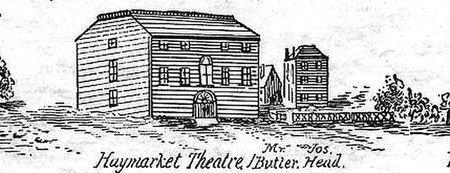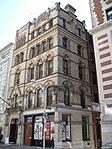Haymarket Theatre (Boston, Massachusetts)
1796 establishments in Massachusetts1803 disestablishments in Massachusetts18th century in BostonBoston Theater DistrictFormer buildings and structures in Boston ... and 2 more
Former theatres in BostonTheatres completed in 1796

The Haymarket Theatre (1796-1803) or Hay-Market Theatre was a theatre in late-18th century Boston, Massachusetts. Organized by Charles Stuart Powell, it occupied a large, wooden building "opposite the Mall on Common (later Tremont) Street, near Hatch's Tavern." In addition to dramatic plays, the theatre presented some 62 musical entertainments during its first 5 years. The Haymarket "was seldom used after 1800, and on March 3, 1803, it was offered for sale at auction on the condition that it be removed in 60 days."
Excerpt from the Wikipedia article Haymarket Theatre (Boston, Massachusetts) (License: CC BY-SA 3.0, Authors, Images).Haymarket Theatre (Boston, Massachusetts)
Tremont Street, Boston Beacon Hill
Geographical coordinates (GPS) Address Nearby Places Show on map
Geographical coordinates (GPS)
| Latitude | Longitude |
|---|---|
| N 42.352741666667 ° | E -71.064355555556 ° |
Address
Ansin Building
Tremont Street 180,182
02111 Boston, Beacon Hill
Massachusetts, United States
Open on Google Maps










